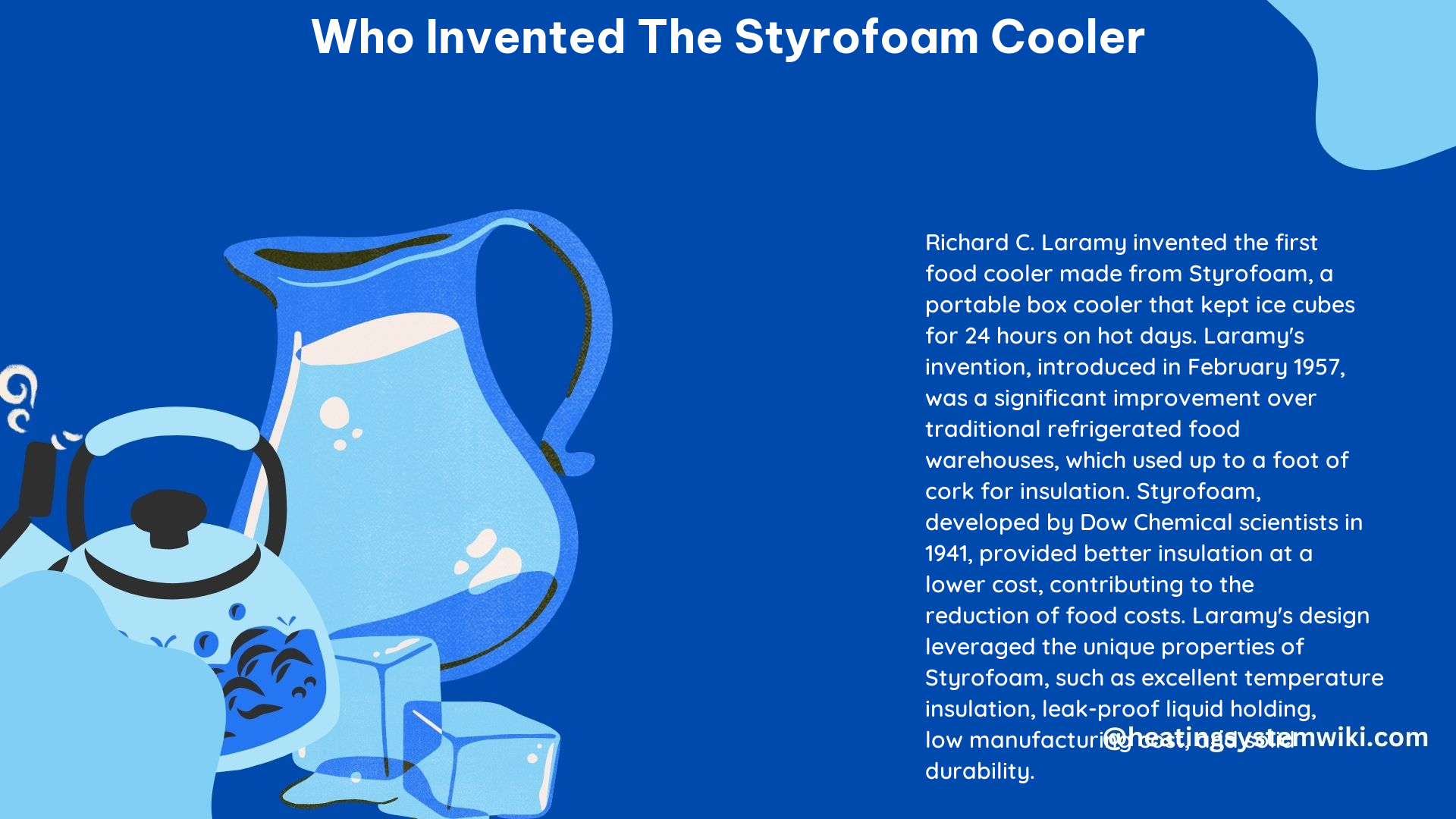The Styrofoam cooler, a ubiquitous item in modern outdoor recreation and commercial shipping, has a fascinating history that dates back to the mid-20th century. This comprehensive guide delves into the invention, evolution, and technical specifications of the Styrofoam cooler, providing a wealth of information for both casual readers and DIY enthusiasts.
The Inventor: Richard C. Laramy
In 1951, Richard C. Laramy, an inventor from the United States, filed a patent application with the U.S. Patent Office for a “portable ice chest for storing foods and the like.” Laramy’s design consisted of an insulated container with a lid and a compartment in the bottom for holding ice. This innovative concept laid the foundation for the modern Styrofoam cooler.
Laramy’s employer, Queen Stove Works, recognized the potential of his design and added several key features, including snap-lock handles and a bottle opener. They then marketed the portable cooler under the name “Kampkold,” which quickly gained popularity among consumers.
The Insulating Material: Styrofoam

The Styrofoam cooler’s rise to prominence was largely due to the unique properties of the insulating material it was made from – Styrofoam. Developed by Dow Chemical engineer Otis McIntire in 1944, Styrofoam (a trademark of Dow Chemical for extruded polystyrene foam) was an inexpensive alternative to rubber and possessed excellent insulating capabilities.
Styrofoam’s ability to effectively insulate and contain liquids, combined with its lightweight and cost-effective manufacturing process, made it an ideal material for the construction of portable coolers. This, in turn, contributed to the widespread adoption and success of the Styrofoam cooler.
The Commercialization: Coleman’s Styrofoam Ice Chest
In 1957, the Coleman Company, a renowned manufacturer of outdoor equipment, introduced the first Styrofoam ice chest. This lightweight and portable cooler was an immediate hit, as it allowed consumers to easily transport their food and beverages to the beach, picnics, and other outdoor activities.
The Styrofoam ice chest also proved to be a valuable asset for commercial customers, particularly those in the emerging field of refrigerated shipping. The cooler’s insulating properties and ability to maintain temperature made it an essential tool for the transportation of perishable goods.
Technical Specifications of the Styrofoam Cooler
The Styrofoam cooler is an insulated container designed to store and refrigerate foods and beverages. Its key technical specifications include:
- Material: Made from Styrofoam, a trademark of Dow Chemical for extruded polystyrene foam.
- Design: Consists of an insulated container with a lid and a compartment in the bottom for holding ice.
- Insulation: Styrofoam has excellent capacity for temperature insulation, keeping the cooler’s contents cold for extended periods.
- Leak-proof: Styrofoam coolers are designed to hold liquids without leaks, ensuring the contents remain dry and contained.
- Lightweight: Styrofoam coolers are much lighter than their metal predecessors, making them easier to transport to various locations.
- Cost-effective: Styrofoam coolers are inexpensive to manufacture, making them an affordable option for personal and commercial use.
DIY Styrofoam Cooler
For those interested in creating their own Styrofoam cooler, the process is relatively straightforward. By following a few simple steps, you can construct a durable and highly insulated cooler using readily available materials.
Materials Needed:
- Two Styrofoam coolers of the same size (one for the outer shell and one for the inner lining)
- Insulating foam sealant
- Spray adhesive
- Heavy-duty zip ties
Tools Needed:
- Utility knife
- Measuring tape
- Straight edge
- Gloves
- Safety glasses
Step-by-Step Instructions:
- Measure and mark the desired size of the inner lining cooler on the second Styrofoam cooler using the measuring tape and straight edge.
- Cut out the inner lining cooler using the utility knife, ensuring a clean and straight cut.
- Apply the insulating foam sealant around the edges of the inner lining cooler to create an airtight seal.
- Allow the foam sealant to dry completely.
- Spray the adhesive on the outer surface of the inner lining cooler and the inner surface of the outer cooler.
- Press the inner lining cooler into the outer cooler, ensuring a snug fit.
- Secure the inner lining cooler to the outer cooler using heavy-duty zip ties, spacing them evenly around the cooler.
- Trim any excess zip tie material using the utility knife.
Your DIY Styrofoam cooler is now ready for use, providing improved insulation and durability compared to a single-layer Styrofoam cooler.
Conclusion
The Styrofoam cooler, a ubiquitous and indispensable item in modern life, has a rich history that can be traced back to the innovative mind of Richard C. Laramy and the groundbreaking work of Dow Chemical engineer Otis McIntire. From its humble beginnings as a “portable ice chest” to its widespread commercial success, the Styrofoam cooler has evolved to become a testament to the power of ingenuity and the enduring appeal of practical, cost-effective solutions.
